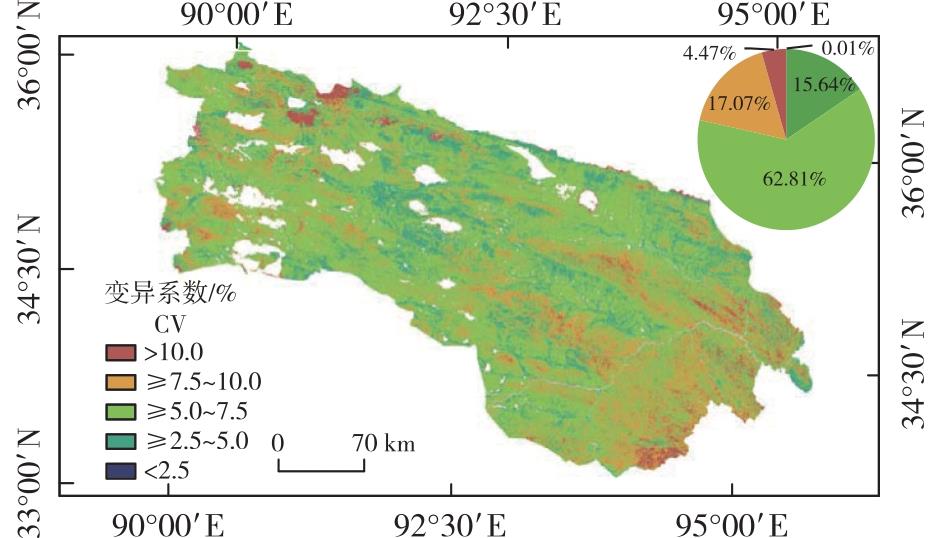 PDF(2524 KB)
PDF(2524 KB)


Dynamic changes and driving forces of ecological environment quality in the source region of the Yangtze River from 1990 to 2020
WANG Tianhong, JIANG Fugen, LONG Yi, DENG Muli, SUN Hua
Journal of Nanjing Forestry University (Natural Sciences Edition) ›› 2025, Vol. 49 ›› Issue (3) : 110-118.
 PDF(2524 KB)
PDF(2524 KB)
 PDF(2524 KB)
PDF(2524 KB)
Dynamic changes and driving forces of ecological environment quality in the source region of the Yangtze River from 1990 to 2020
【Objective】Accurately and efficiently monitoring the spatio-temporal distribution characteristics of the ecological environment quality and its evolving trends in the source area of the Yangtze River is of great significance for maintaining the high-standard protection of the ecological environment. It also serves as a fundamental basis for formulating long-term and effective ecological protection and restoration strategies in the Sanjiangyuan region. The remote sensing ecological index (RSEI) has distinct advantages over traditional evaluation methods relying on single monitoring indices. It boasts rapid assessment capabilities, objectivity, high efficiency, strong visual interpretability, and reliable predictability. Nevertheless, the spatial resolution constraints and the complexity of data acquisition and processing in remote sensing images still present challenges to the large-scale and accurate evaluation of the RSEI.【Method】In this study, the Google Earth Engine (GEE) platform was utilized, with Landsat series images as the data source. Remote sensing images of the Yangtze River source area during the vegetation-growing season (from June to September) from 1990 to 2020 were obtained. Subsequently, long-time-series RSEI data were calculated. To comprehensively analyze the RSEI in the Yangtze River source area from 1990 to 2020, the coefficient of variation was applied to measure its stability, the Sen + Mann-Kendall (Sen + MK) trend analysis was used to explore the spatio-temporal change trends, the Hurst index was employed to predict future evolution, and the trend analysis method was adopted to identify the driving forces behind these changes.【Result】(1) From 1990 to 2020, the RSEI values in the Yangtze River source region were predominantly distributed within the range of 0.4-0.6. Geographically, the region exhibited a clear pattern where the RSEI values were higher in the eastern and southern parts and lower in the western and northern parts.(2) The average coefficient of variation of the RSEI in the source region was 6.52%. This indicates that the ecological environment in the eastern and western regions underwent relatively more pronounced fluctuations, while the central region remained relatively stable. Overall, the RSEI showed a slow oscillating trend, with an average annual growth rate of 0.004 7. Spatially, the RSEI presented an overall upward trend, and the area with improved ecological conditions accounted for 83.63% of the total study area.(3) The average Hurst index value of the RSEI in the source region was 0.53, implying that the future changes of the RSEI were more likely to be continuous rather than show anti-sustainability. The future ecological environment quality in the Yangtze River source region was expected to experience continuous improvement, yet the overall trend was relatively mild, and there still existed an underlying risk of degradation.(4) In the Yangtze River source region, the RSEI was positively correlated with air temperature, night-light index, and potential evapotranspiration. This reveals that both natural factors and human activities had a certain degree of influence on the enhancement of the ecological environment quality.【Conclusion】The integration of using GEE for remote sensing data acquisition and time-series data analysis has significant potential for rapidly and comprehensively monitoring the ecological environment quality on a large scale. This approach can offer valuable references and technical support for ecological monitoring and protection efforts in the Sanjiangyuan area, thereby contributing to the sustainable development of the regional ecological environment.

Yangtze River source region / remote sensing ecological index (RSEI) / ecological environment quality / Google Earth Engine (GEE) / Hurst index
| [1] |
樊江文, 邵全琴, 刘纪远, 等. 1988—2005年三江源草地产草量变化动态分析[J]. 草地学报, 2010, 18(1):5-10.
|
| [2] |
张彩红, 薛伟, 辛颖, 等. 基于层次分析法的贵州玉舍国家森林公园休养地适宜度评价[J]. 南京林业大学学报(自然科学版), 2020, 44(2):215-219.
|
| [3] |
任继周, 林慧龙. 江河源区草地生态建设构想[J]. 草业学报, 2005, 14(2):1-8.
|
| [4] |
陈兴, 余正勇. 三江源国家公园生态保护研究进展与展望[J]. 国土资源科技管理, 2022, 39(2):13-24.
|
| [5] |
刘栩位, 周启刚, 周浪, 等. 基于RSEI的三峡库区重庆段水土保持生态功能区生态环境质量动态监测[J]. 水土保持研究, 2021, 28(5):278-286.
|
| [6] |
|
| [7] |
徐涵秋. 区域生态环境变化的遥感评价指数[J]. 中国环境科学, 2013, 33(5):889-897.
|
| [8] |
|
| [9] |
|
| [10] |
李婷婷, 马超, 郭增长. 基于RSEI模型的贺兰山长时序生态质量评价及影响因素分析[J]. 生态学杂志, 2021, 40(4):1154-1165.
|
| [11] |
|
| [12] |
|
| [13] |
叶有华, 梁永贤, 沈一青, 等. 《生态环境状况评价技术规范(试行)》中若干值得商榷的问题[J]. 热带地理, 2009, 29(4):404-406.
|
| [14] |
陈炜, 黄慧萍, 田亦陈, 等. 基于Google Earth Engine平台的三江源地区生态环境质量动态监测与分析[J]. 地球信息科学学报, 2019, 21(9):1382-1391.
|
| [15] |
赵慧芳, 曹晓云. 三江源国家公园植被覆盖时空变化及其气候驱动因素[J]. 高原气象, 2022, 41(2):328-337.
|
| [16] |
许茜, 李奇, 陈懂懂, 等. 近40 a三江源地区土地利用变化动态分析及预测[J]. 干旱区研究, 2018, 35(3):695-704.
|
| [17] |
李璠, 颜亮东, 赵梦凡, 等. 三江源地区生长季降水特征对土壤水分的影响[J]. 干旱区资源与环境, 2022, 36(6):121-128.
|
| [18] |
张妹婷, 翟永洪, 张志军, 等. 三江源区草地生态系统质量及其动态变化[J]. 环境科学研究, 2017, 30(1):75-81.
|
| [19] |
|
| [20] |
李洪果, 陈达镇, 许靖诗, 等. 濒危植物格木天然种群的表型多样性及变异[J]. 林业科学, 2019, 55(4):69-83.
|
| [21] |
黄晓军, 祁明月, 李艳雨, 等. 关中地区PM2.5时空演化及人口暴露风险[J]. 环境科学, 2020, 41(12):5245-5255.
|
| [22] |
|
| [23] |
徐嘉昕, 房世波, 张廷斌, 等. 2000—2016年三江源区植被生长季NDVI变化及其对气候因子的响应[J]. 国土资源遥感, 2020, 32(1):237-246.
|
| [24] |
周侃, 张健, 虞虎, 等. 国家公园及周边地区人为扰动强度的时空变化与驱动因素:以三江源国家公园为例[J]. 生态学报, 2022, 42(14):5574-5585.
|
| [25] |
桑国庆, 唐志光, 邓刚, 等. 基于MODIS NDVI时序数据的湖南省植被变化研究[J]. 长江流域资源与环境, 2021, 30(5):1100-1109.
|
| [26] |
徐丽娇, 胡泽勇, 赵亚楠, 等. 1961—2010年青藏高原气候变化特征分析[J]. 高原气象, 2019, 38(5):911-919.
|
| [27] |
卢明星, 徐传红, 朱咏莉, 等. Cd诱导土壤ALP的Hormesis效应:土地利用变化的驱动机制[J]. 南京林业大学学报(自然科学版), 2020, 44(2):173-180.
|
| [28] |
|
| [29] |
赵风华, 于贵瑞. 陆地生态系统碳-水耦合机制初探[J]. 地理科学进展, 2008, 27(1):32-38.
|
/
| 〈 |
|
〉 |